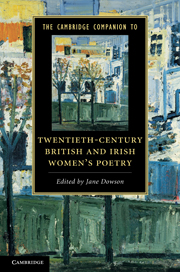Book contents
- Frontmatter
- 1 Introduction
- 2 Post/Modernist rhythms and voices: Edith Sitwell and Stevie Smith to Jo Shapcott and Selima Hill
- 3 Reframing women’s war poetry
- 4 Verbal and visual art in twentieth-century British women’s poetry
- 5 Towards a new confessionalism
- 6 The mid-Atlantic imagination: Mina Loy, Ruth Fainlight, Anne Stevenson, Anne Rouse and Eva Salzman
- 7 The Irish history wars and Irish women’s poetry: Eiléan Ní Chuilleanáin and Eavan Boland
- 8 Interculturalism: Imtiaz Dharker, Patience Agbabi, Jackie Kay and contemporary Irish poets
- 9 Post-pastoral perspectives on landscape and culture
- 10 Feminism’s experimental ‘work at the language-face’
- 11 Carol Ann Duffy, Medbh McGuckian and ruptures in the lines of communication
- Selected reading
- Index
9 - Post-pastoral perspectives on landscape and culture
Published online by Cambridge University Press: 28 May 2011
- Frontmatter
- 1 Introduction
- 2 Post/Modernist rhythms and voices: Edith Sitwell and Stevie Smith to Jo Shapcott and Selima Hill
- 3 Reframing women’s war poetry
- 4 Verbal and visual art in twentieth-century British women’s poetry
- 5 Towards a new confessionalism
- 6 The mid-Atlantic imagination: Mina Loy, Ruth Fainlight, Anne Stevenson, Anne Rouse and Eva Salzman
- 7 The Irish history wars and Irish women’s poetry: Eiléan Ní Chuilleanáin and Eavan Boland
- 8 Interculturalism: Imtiaz Dharker, Patience Agbabi, Jackie Kay and contemporary Irish poets
- 9 Post-pastoral perspectives on landscape and culture
- 10 Feminism’s experimental ‘work at the language-face’
- 11 Carol Ann Duffy, Medbh McGuckian and ruptures in the lines of communication
- Selected reading
- Index
Summary
If ever it testified to the innocent charms of an unspoiled natural world, in the course of the twentieth century the literary ‘pastoral’ has become a dangerously prodigal signifier. That said, most pastoral writing affirms the inescapably dialectical relation of urban and rural environments. For a growing number of critics like Terry Gifford, the ‘post-pastoral’ crucially reconfigures the ‘closed circuit of pastoral and anti-pastoral’, with its more holistic ‘vision of an integrated natural world that includes the human’. As Gifford says: ‘Now we have as much an interest in the welfare of Arden as in that of its exiled inhabitants, as much interest in their interaction with Arden as in what they take back from it, as much interest in how they represent their interaction with it as in how their representations of themselves as its inhabitants have changed.’ Keeping the culturally undecidable location of Arden firmly in mind, this chapter explores how the complexities of the post-pastoral play out in poetry by British and Irish women towards and beyond the end of the twentieth century. It focuses particularly on the way in which landscape enshrines the integration of the natural and the human; as John Kinsella notes, the pastoral has only ever been ‘about landscape . . . how land and the people within the land are marked – where signs of authenticity and belonging are imposed or laid’. The poets treated here all insist, with the eco-critic Jonathan Bate, that ‘every piece of land is itself a text with its own syntax and signifying potential’. Invariably for them, significantly, ‘landscape provides a way into the question of culture’.
- Type
- Chapter
- Information
- Publisher: Cambridge University PressPrint publication year: 2011
- 2
- Cited by



